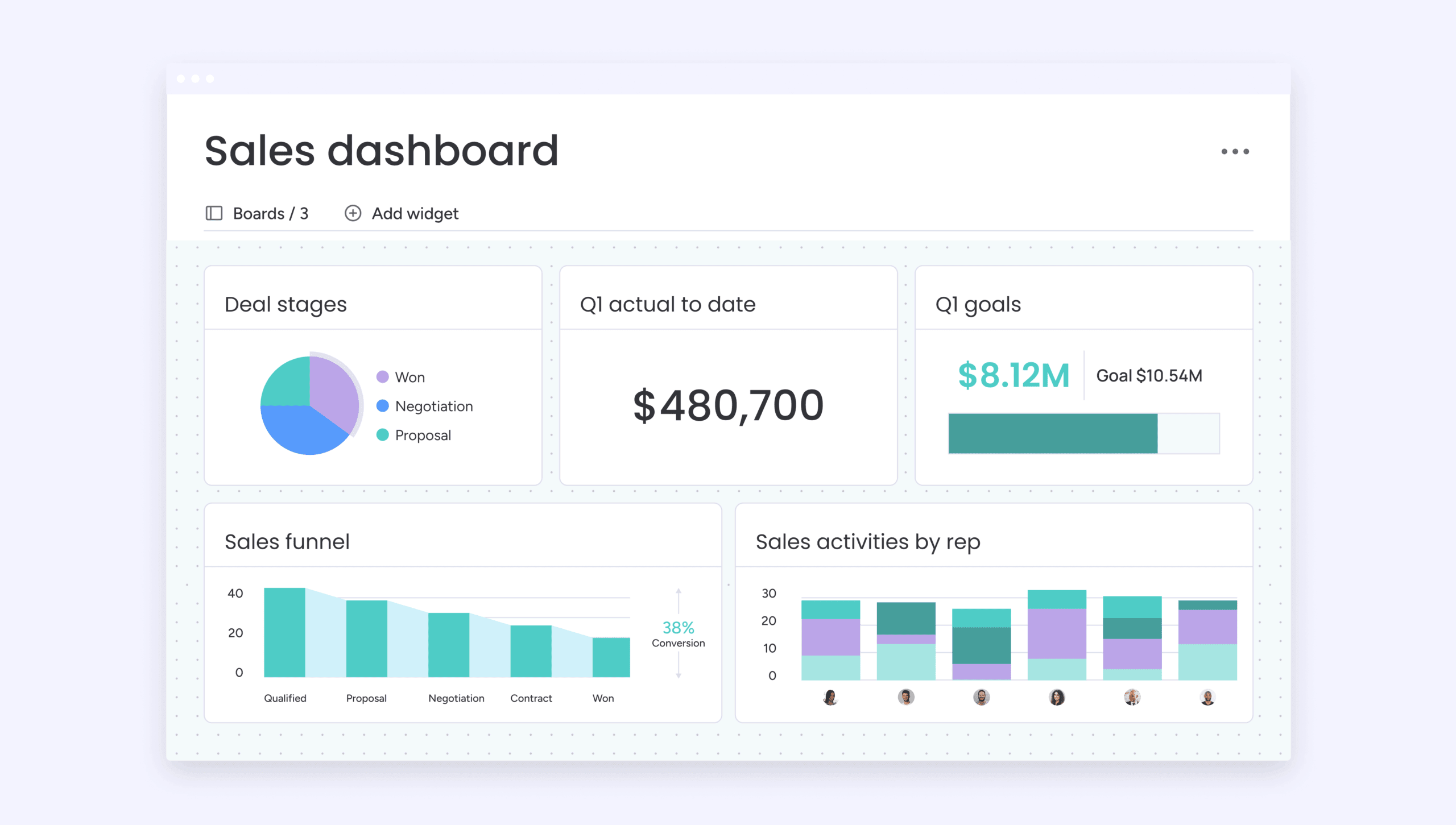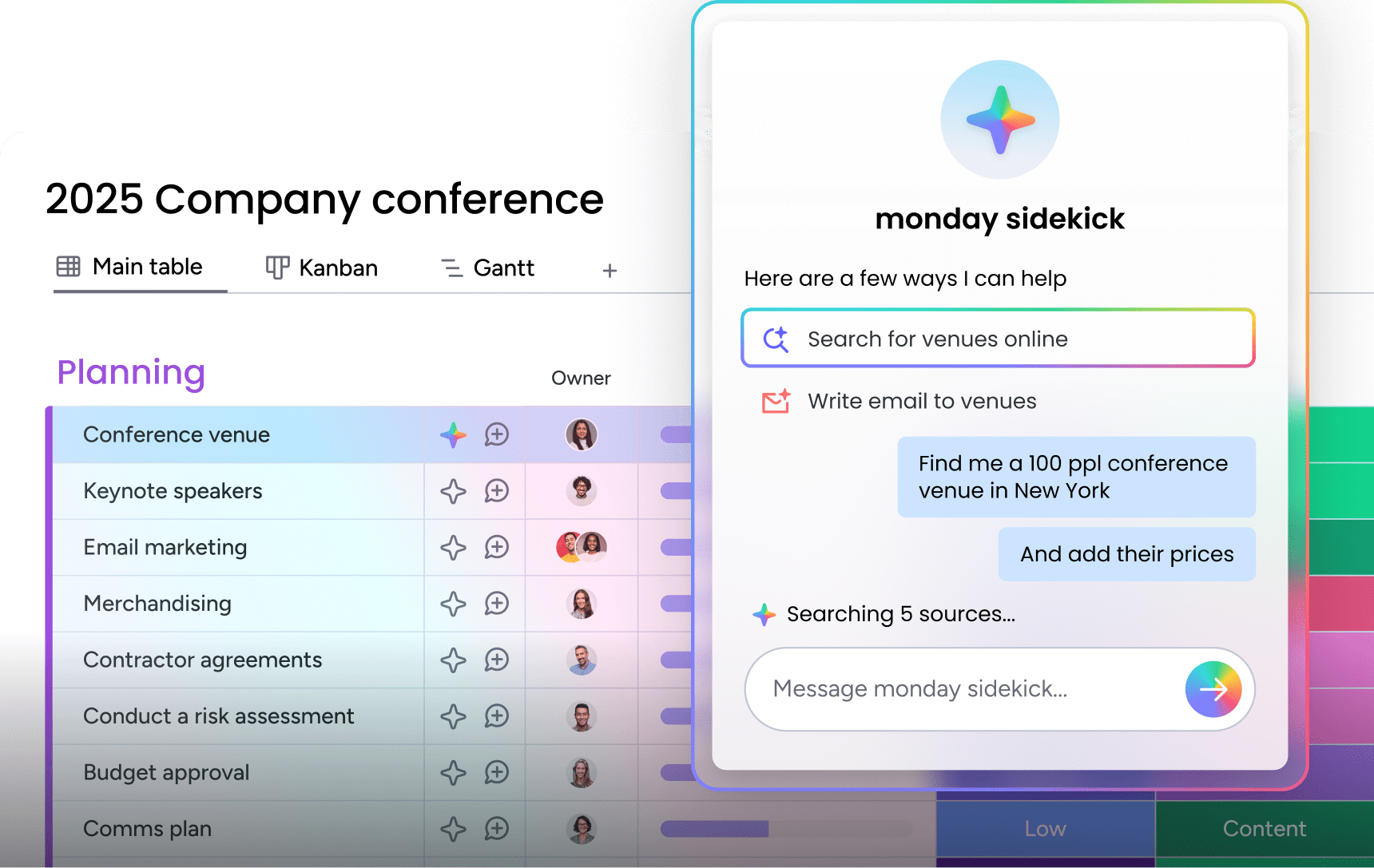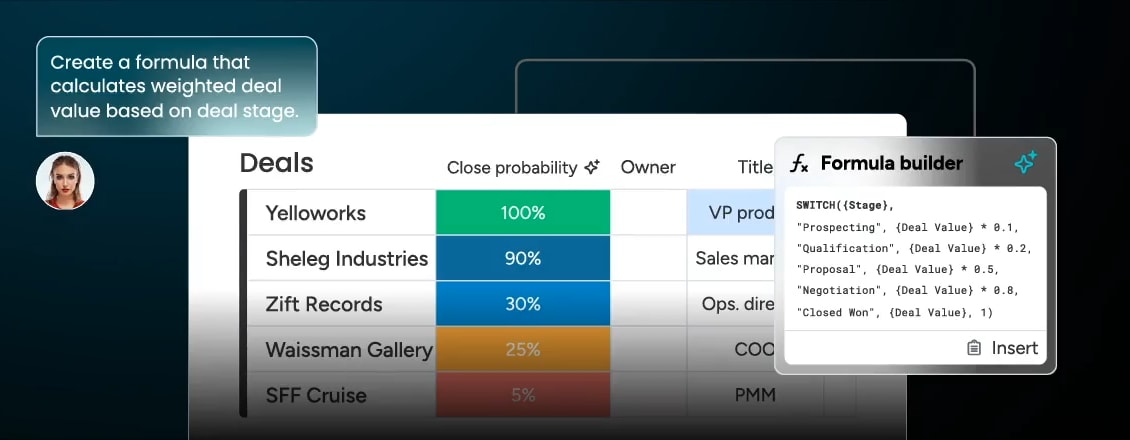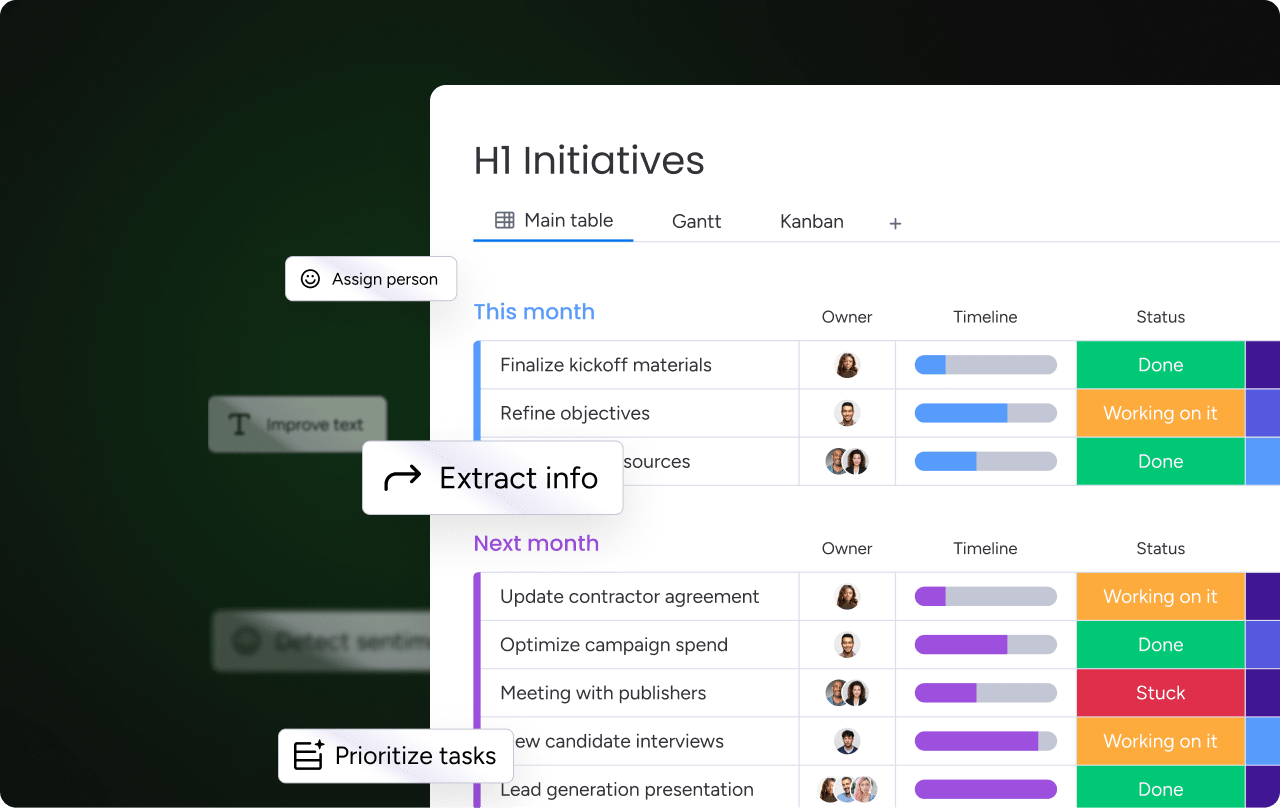Sales operations is the backbone of modern revenue teams. It’s the discipline that brings together people, processes, data, and technology to help sales reps close deals more efficiently. While sales reps focus on building relationships and driving revenue, sales operations teams ensure everything behind the scenes runs smoothly — from territory planning and forecasting to CRM management and automation.
In this guide, you’ll learn what sales operations is, the roles it covers, and the strategies, KPIs, and tools you can use to build an effective plan. We’ll also explore how AI and sales and operations planning (S&OP) are reshaping the field, plus how monday CRM can power it all.
Try monday CRMWhat is sales operations?
Sales operations is a combination of the tools, strategies, and activities a team employs to support sales initiatives. Sales ops normally involves relying on both technology and data to improve sales processes and build a comprehensive approach to sales.
Overall, the vision for strategic sales operations is to help sales agents work more efficiently and maximize revenue opportunities by optimizing various sales processes.
Companies often implement several sales tools and systems, and the role of sales operations is to make sure technologies are being used as efficiently as possible through strategic planning and data analysis.
How do sales operations help your business grow?
Sales operations teams handle S&OP, sales and operations planning, to make sure every aspect of the sales process is working smoothly. Building a sales ops team creates a significant expense for businesses between manpower and resources, but S&OP can lead to significant growth, making it a worthwhile investment.
Let’s take a closer look at a few quick examples of how S&OP leads to business growth:
- Improved efficiency and organization help teams standardize processes to avoid stalled deals and bottlenecks in the sales funnel.
- Data-driven decision-making ensures teams can act on insights with greater accuracy and confidence.
- Smarter use of sales technology makes it easier to optimize tools and confirm they’re meeting team needs.
- Stronger cross-team collaboration allows S&OP to align departments and reduce miscommunication.
- Company-wide best practices turn successful processes into repeatable methods that boost productivity and profitability.
What about sales inventory operations planning?
A subset of S&OP is sales inventory operations planning (SIOP). This process focuses specifically on balancing demand and inventory to prevent both overstock and stockouts.
By aligning sales forecasts with supply chain data, businesses can reduce costs, improve customer satisfaction, and ensure product availability. SIOP is especially critical for industries with complex distribution networks or seasonal demand cycles.
Sales operations vs. sales enablement: What’s the difference?
Sales operations and sales enablement may sound interchangeable. They’re both focused on improving sales efficiency, but through different methods and practices. Sales ops involves data analysis and the systematic optimization of sales processes, while sales enablement is about directly empowering sales reps with the tools, training, and content they need. The table below provides a side-by-side breakdown of their differences.
| Sales operations | Sales enablement | |
|---|---|---|
| Focus | Tools, systems, processes, and data analysis | Front-line sales rep empowerment and performance |
| Key activities | CRM management, forecasting, territory planning, quota setting | Training programs, content creation, coaching, onboarding |
| Target audience | Sales leadership and organizational strategy | Individual sales reps and teams |
| Tracked metrics | Pipeline health, conversion rates, sales cycle length, revenue forecasting | Rep productivity, content usage, skill development, quota attainment |
| Sales funnel | Works across the entire funnel to optimize flow and measure performance | Focuses primarily on middle and bottom funnel activities where reps engage prospects |
What are the different roles in a sales operations team?
The size of your sales ops team will depend on your business goals and how big your existing team is. You can have a sales operations team with dozens of employees, or just one person to oversee it all if you’re a small business. When growing out your sales ops team, consider building responsibilities around the roles below.
- Vice president or director of sales operations: Oversees the sales ops team and develops strategies to increase productivity
- Sales operations manager: Translates S&OP strategy into daily processes, plans, and best practices for reps
- Sales operations specialist: Coordinates and supports reps with contracts, cross-department communication, and scheduling
- Sales operations analyst: Analyzes data using CRM tools to identify trends, forecast sales, and recommend improvements
- Sales operations representative: Handles daily administrative tasks such as reporting, data entry, and progress tracking
Sales operations strategies: How to build a strong sales operations plan
It’s the job of the sales ops team to innovate and help the front line step up their game. That’s a big job, but implementing established best practices can help break the process down into a manageable plan.
1. Create a mission statement
The sales ops team should start by defining their mission and purpose, making sure that it aligns with the sales team and distributing it company-wide. In the mission statement, avoid vague statements in favor of concrete ones that outline the “how” of achieving each goal, like “Automate more operational tasks to free up time in the case queue.”
2. Foster collaboration
Consistent communication between sales ops and the sales, marketing, and sales enablement teams is crucial to keeping a sales operations team running smoothly and avoiding repetitive work. A weekly meeting between the team leaders to review changes and maintain alignment will help teams collaborate seamlessly.
3. Establish a clear leadership structure
Someone high-level, like a director or vice president, should lead the sales operations team and report to the C-suite. This establishes a clear chain of command and ensures sales ops has the authority to implement changes.
4. Shadow sales team members
Having sales operations staff work closely with people on the sales team will give them first-hand experience with daily duties and challenges. This helps them better guide overall sales strategy while forming deeper connections between teams.
5. Stay innovative
The sales operations team should continually monitor what’s working and what can be improved, adopting new technology or policies that make sense. That said, this needs to be done at an appropriate pace since your sales team won’t get much done if they need to be trained every week.
AI in sales operations: How it changes the game
Artificial intelligence is transforming sales operations from reactive to proactive. Instead of waiting for reports to be pulled or data to be analyzed manually, AI surfaces insights in real time and helps teams act faster. Here’s how AI is reshaping sales ops today:
- Forecasting with accuracy: AI models analyze historical sales data and market signals to predict revenue more reliably.
- Smarter automation: Repetitive tasks like lead qualification, email follow-ups, and meeting notes can be automated, freeing reps to focus on selling.
- Better decision-making: AI dashboards highlight patterns and trends that humans might miss, turning raw data into actionable insights.
- Conversational support: AI assistants, like monday sidekick, can draft emails, generate sales content, or answer questions about pipeline performance instantly.
With platforms like monday CRM, these capabilities are built right into daily workflows, making AI a core driver of sales efficiency.
Measuring success: Important KPIs and metrics to track for sales operations
Sales ops teams can be costly and resource-intensive, which is why it’s essential to keep tabs on how they’re impacting sales efficiency. The metrics and KPIs below are a good starting point for measuring how successful your sales operations are overall.
- Sales cycle length: Measures sales cycle (how long it takes to close a deal), showing whether sales ops successfully removed inefficiencies
- Customer acquisition cost (CAC): Tracks the cost of acquiring new customers and reveals if S&OP initiatives are lowering expenses
- Customer lifetime value (CLV): Indicates overall customer satisfaction and long-term revenue potential
- Churn rate: Shows how well teams are retaining existing customers and highlights where engagement strategies need improvement
- Win rate: Reflects the percentage of deals closed compared to opportunities created
- Sales team turnover: Measures rep retention and provides insight into team satisfaction and stability
- Lead conversion rate: Tracks how effectively leads are moving from prospect to customer
- Forecast accuracy: Assesses how closely predicted revenue matches actual performance
- Close rate: Provides a big-picture view of overall sales effectiveness
- Sales pipeline velocity: Reveals how quickly deals move through the pipeline and where they may be stalling
- Average lead response time: Measures how long it takes reps to follow up with prospects, indicating whether additional automation is needed
Upgrade sales operations planning with monday CRM
Both sales agents and sales operations teams can use a CRM system to improve collaboration and communication. Having a unified platform that operates a single source of truth for both teams, or even additional departments, makes it simpler to improve operations across the board. Software like monday CRM helps sales operations teams create data-based sales plans that sales agents can implement in their daily work through trackable tasks.
To take your strategies even further, monday CRM is equipped with advanced artificial intelligence for sales that has the power to completely change your operations. According to research by Gartner, sales teams that use AI are 3.7x more likely to reach sales quotas. With the platform’s built-in AI features, teams can automate sales workflows with no-code AI-powered automations, generate sales content in a flash, and get predictive insights to power strategic decision-making. The combination of advanced technology with AI-led automation that teams get from a platform like monday CRM creates a comprehensive solution that drives strategic growth and delivers measurable results across an entire organization.
Here’s a closer look at some of the features that allow sales operations teams to increase productivity with monday CRM.
Get actionable AI-powered insights

With monday CRM’s AI data analytics, teams get instantly generated reports that assess real-time performance along with dashboards to track sales progress. Thanks to AI, teams can identify patterns and trends that would otherwise go unnoticed, automatically highlighting opportunities for improvement to optimize sales strategies.
Level up revenue teams with monday sidekick

Make it easier for sales reps to focus on building relationships and closing deals with monday sidekick, a built-in AI digital worker. Operating as an autonomous agent, monday sidekick can help sales reps execute strategies by writing emails, creating sales pitches, or generating sales reports through simple natural language prompts.
Build data-based plans with sales forecasting

Get accurate predictive data with monday CRM’s sales forecasting, boosted by AI. Our State of sales technology 2025 report shows that 82% of respondents use AI to boost productivity, with sales forecasting being one of the primary applications. Teams that employ sales management software with AI-powered sales forecasting features, like monday CRM, can benefit from accurate projections and smart suggestions to course correct when needed.
Create effective sales processes with AI automations

Whether managing incoming leads or summarizing meetings, teams can create custom AI-powered automations in an instant. AI can help teams automate lead qualification, scoring, and routing to make lead management simpler, auto-summarize meetings and long email chains, create tasks from the key takeaways, and categorize tasks based on priority level.
4 best practices for great sales operations teams
Sales ops teams have a lot on their plate. There are countless processes and responsibilities to monitor and plan for, which can make it easy for work to get disorganized if you’re not careful. Here are a few key tips and best practices teams can implement to make S&OP planning a little smoother.
1. Decide which metrics to focus on
There are a lot of different metrics and KPIs that sales ops teams can track, as we saw earlier. Measuring success doesn’t always mean tracking endless metrics, but rather honing in on the ones your team needs to work on most based on short and long-term sales goals.
2. Keep records of plans and strategies
It’s likely that your early sales operations plan won’t run as smoothly as you wanted, and that’s ok. For sales ops teams to succeed, they need to constantly improve strategies using tangible data, so make sure you have a system in place to keep records of previous plans to make it easier to track improvements and changes over time.
3. Use the right tools to help plan
When forming your sales ops team, you also want to consider which tools your team will need most. Be selective and strategic about where to apply technology, focusing on tools that have the most wide-reaching uses, such as a CRM, sales enablement software, or analytics tools.
One multi-functional tool, such as an AI-powered CRM platform like monday CRM, is better than a dozen separate programs that your team has to learn to use.
4. Focus on sales process automation
When looking for ways to make sales operations more efficient, start by breaking down which processes can be automated. For example, you can automate lead qualification with a smart AI-powered CRM so that sales reps don’t waste time manually combing through leads to decide which ones to focus on.
What’s next for sales operations: Key trends
Looking ahead, AI in sales operations will continue to transform how teams analyze data, predict sales, and automate processes. Here’s what you can expect to see:
- Deeper predictive analytics that improve forecasting and resource allocation
- Conversational AI tools that assist reps in real time with content, emails, and customer engagement
- Hyper-personalization that tailors strategies and outreach to individual buyer behaviors
These trends will push sales operations from efficiency-focused to insight-driven, helping teams become more strategic partners to the business.
Drive growth with smarter sales operations
Sales operations is the engine that turns sales strategy into measurable results. By aligning data, processes, and technology, sales ops teams give reps the focus and support they need to close more deals.
With monday CRM, you can take this even further, streamlining sales and operations planning to tap into AI-powered insights and automate workflows at scale. The result is a sales organization that’s not just more efficient, but primed for sustainable growth.
Try monday CRMFAQs
How can you optimize sales operations?
Organizations can optimize sales operations by streamlining processes, implementing data-driven decision-making, and automating repetitive tasks. Focus on making the most of your CRM platform, establishing clear metrics and KPIs to track, and promoting cross-team collaboration. Finally, invest in proper training and make sure to be selective about the technology you use and that it supports team productivity.
What is sales and operations planning, and how is it implemented?
Sales and operations planning (S&OP) is an integrated process that aligns supply and demand along with financial and operational planning. Implementing a S&OP process involves monthly meetings between sales, operations, finance, and leadership teams to review demand forecasts, capacity constraints, and financial targets, then using data to build plans that balance customer demand with business capabilities.
How is sales and operations planning used in supply chain management?
In supply chain management, S&OP coordinates demand planning with supply capabilities, inventory levels, and production schedules. It helps optimize inventory investment, reduce stockouts, improve customer service levels, and manage efficient resource allocation in a supply network by aligning sales forecasts with procurement, manufacturing, and distribution plans.
What are the 7 steps of the sales process?
The seven steps are: prospecting (identifying potential customers), preparation (researching prospects), approach (initial contact), presentation (demonstrating value), handling objections (addressing concerns), closing (securing the deal), and follow-up (maintaining relationships and ensuring satisfaction). Each step builds toward converting prospects into loyal customers.
What is the difference between S&OP and MRP?
S&OP is a strategic, cross-functional planning process that balances demand and supply at an executive level, typically with monthly cycles. MRP (Material Requirements Planning) is a system that calculates specific material required based on production schedules, operating at an operational level with shorter time horizons.
What are sales operations KPIs?
Key performance indicators (KPIs) for sales operations include sales cycle length, win rate, customer acquisition cost, churn rate, forecast accuracy, and pipeline velocity. These metrics help teams measure efficiency, identify bottlenecks, and prove the impact of sales operations on revenue growth.
 Get started
Get started 


